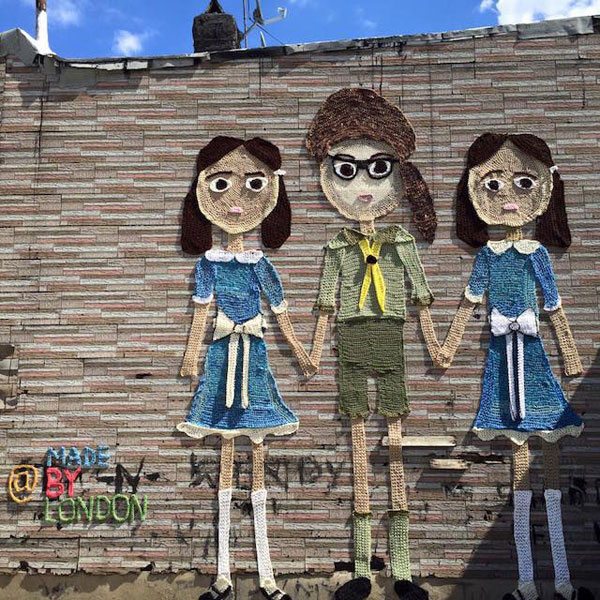
September 11, 2017; Artsy
Much has been made about artists gentrifying working-class neighborhoods and neighborhoods of color seemingly just by moving in. Some activists have called this “a new form of colonization.” Writing for CityLab, Peter Moskowitz recently wrote about how this happens and what artists can do about it.
Moskowitz traces the trope of the artist-as-gentrifier to a 1984 essay, “The Fine Art of Gentrification.” It described it as “galleries as white-majority spaces that gave developers reasons to buy up land; the fear of original residents being priced out; a local press fawning over the new ‘revitalization’ of the neighborhood; and insensitive artists benefitting from it all.”
In 2015, Will Giron’s Bushwick gentrification story went viral. Giron’s aunt’s Bushwick building (which she owned) was “yarn-bombed” by Los Angeles-born artist London Kaye, who hung a large, crochet installation without her permission. When Giron, “a lifelong New Yorker and tenants’ rights activist,” complained, Rob Abner, the head of Bushwick Flea, threatened to report his aunt to the Department of Health for selling Salvadorian food outside her building. Giron said, “It was really about agency. People come in and act like they can do whatever they want. Kaye wouldn’t have done the same thing on Long Island or in a white neighborhood.”
Moskowitz notes that people of color and lower-income white people have been living in cities before sociologist Ruth Glass coined the term “gentrification” in 1964. Back then, there was no story about artists driving up real estate values. However, after World War II, the federal government’s homeownership-for-whites program created white, middle-class suburbs and depressed inner cities, largely the result of redlining, which designated neighborhoods with “too many people of color” ineligible for mortgages.
Sign up for our free newsletters
Subscribe to NPQ's newsletters to have our top stories delivered directly to your inbox.
By signing up, you agree to our privacy policy and terms of use, and to receive messages from NPQ and our partners.
According to Moskowitz, this created “for the first time in American history” a reality where “the majority of white people were living largely privatized lives in single-family homes, without many community spaces or diversity.” While Moskowitz attributes much of this to federal policy, the truth is that white people were seeking to escape the increasing diversity of cities.
Some white children of this “economic and cultural experiment” didn’t like the sterile suburban culture, and in the 1970s they began moving back into cities. However, Moskowitz notes that while the pre-suburbs white artist was intimately engaged in social change, post-suburbs white artists are “the products of an unnatural environment of hetero- and racial supremacy.” They had the “aesthetic, economic, and spatial values of the suburbs.” These artists cared more about marketable art than art that inspired social change.
A second factor was that art was overtaken by capitalism. Expensive MFA programs, according to Sarah Schulman, author of Gentrification of the Mind: Witness to a Lost Imagination, “essentially sort artists by race, class, and aesthetic, determining ‘who will be allowed into the reward system.’” The result was art graduates moving to cities with the goal of winning in the art market.
Finally, government grants and tax breaks to real estate developers also fostered gentrification. Moskowitz writes, “the conversion of SoHo from factories to artists’ lofts (and now high-end retail space) was not a natural progression.” Sharon Zukin wrote “a landmark study on artists and gentrification published in the 1980s” titled Loft Living: Culture and Capital in Urban Change. She found that rezoning and changes in law incentivized the conversion of industrial spaces into residential ones called live/work spaces. This supported artists to live in cities. Today, however, living in gentrified cities can be challenging for artists. As Rebecca Solnit writes in her book Hollow City: The Siege of San Francisco and The Crisis of American Urbanism, in the 1960s, an artist would have to work 65 hours a month at minimum wage to afford an apartment in San Francisco, but today, they’d have to work 350 hours a month. Artists today must rely on family wealth or other sponsorship support, or else make art that makes a lot of money. Nevertheless, as Schulman said, “It’s a currency move—they see it as a way to access power, because other white artists, and people who run the art market, live there.”
Becky Amato, NYU’s associate director of Civic Engagement Initiatives at the Gallatin School, sums it up: “There’s an unconscious collaboration between artists interested in living in gentrifying cities, and the market forces and developers who benefit from them.” Still, Moskowitz concludes, “anti-gentrification activists say artists can work against the process that turns their lives and work into policies and projects that lead to displacement.” Artists can join their local community’s housing activism and refuse to let their art or galleries become white-dominant spaces. In short, artists need to go back to identifying with resistance movements and figuring out how to link them to the art world.—Cyndi Suarez











